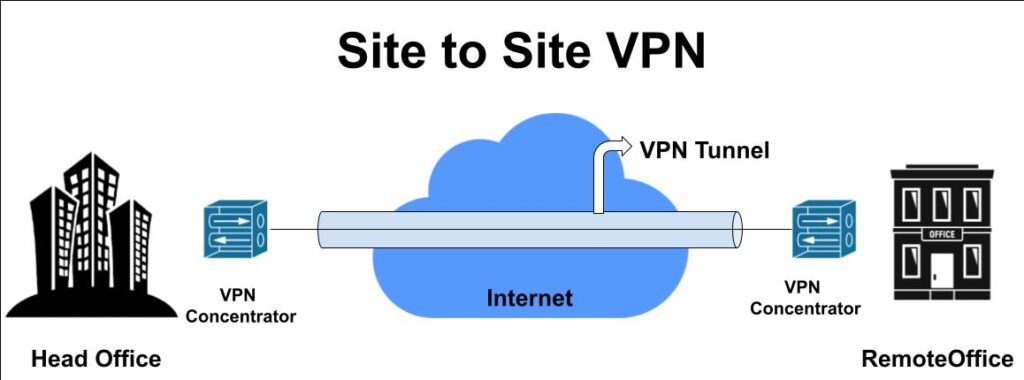What Is Site to Site VPN ?
A Site-to-Site VPN is also known as Router-to-Router or LAN-to-LAN VPN. A site to site VPN is essentially a private network developed to hide private intranets and allow users of these secure networks to access each other’s resources & communication. Site to site VPN is basically used by large corporates. Organizations and corporates with various branch offices in different geographical locations, use Site-to-site VPN to connect the network of one office branch location to the network of another office branch location. Site-to-site VPN create a imaginary tunnel between the networks at geographically distant offices and connect them through the Internet with a secure and private communication channel.

What Is Remote Access VPN ?
Remote access VPN is also known as client-to-site VPN. Remote Access VPN allows a remote user who is working from their home to connect to a corporate’s private network and access all its services and resources remotely. Employees can dial into the company network from their home office via the secure connection and act as if they were sitting in the office. The connection between the remote user and the private network is secure, private and encrypted. This is the most increasingly form of VPN, It prevents third parties from accessing and compromising the network connection.

Difference between Site to Site VPN & Remote Access VPN
Site to Site VPN and Remote Access VPN both are virtual private network used to create a private network tunnel or bridge for secure data transfer and communication. The major difference between these two VPNs are given below.
| Serial No | Site to Site VPN | Remote Access VPN |
| 1 | Site to Site VPN uses a security method known as IPSec for creating encrypted tunnel. | Remote Access VPN uses SSL & IPSec method for creating encrypted tunnel. |
| 2 | In Site to Site VPN no need to set up the network by each end client. | On other hand in case of Remote Access VPN each end client need to set up the network |
| 3 | Site to Site VPN get commonly used in Office LAN users of branch offices that need to connect to servers in head-quarters. | While in Remote Access VPN widely used for Roaming users who want to access servers securely. |
| 4 | In Site to Site VPN no client software is required on user’s machine to access VPN. | In Remote Access VPN client software is required on user’s machine to access VPN. |
| 5 | In Site to Site VPN, the VPN gateway from one LAN communicates with the VPN gateway of another LAN and creates encrypted VPN tunnel. | In Remote Access VPN, the user’s device communicates with VPN gateway using a secure encrypted VPN tunnel. |
| 6 | Site to Site VPN allows multiple users or VLANs traffic to pass through each VPN tunnel. | Remote Access VPN does not allow multiple users or VLANs traffic to pass through each VPN tunnel. |
Advantages Of Using VPN
- Keep You Safe: VPN secure your communication while surfing on internet. And protect you from online threats like scams, frauds and hackers.
- Protect Your Data: VPN secure your communication by creating an imaginary tunnel, and when your data moves through this tunnel it encrypt your data and keeps your data private from third parties.
- Access Blocked Content: With the help of VPN you can hide your IP address and change your location from one country to another country, and access blocked websites and services which is censored in your country.
- Save Your Money: By using VPN you save your money. Many e-commerce websites like amazon & Ali-express display different prices to different countries. Suppose an Iphone price is 1000$ in your country but 800$ in Dubai, Just change your location by using VPN and purchased it.
- Affordable Security: You can buy a VPN service only few dollars. And unblock any website you want and keep your connection anonymous and secure. VPNs are significantly cheaper than other types of security plans. Instead of hiring security analyst, you can use VPN for your network security.

